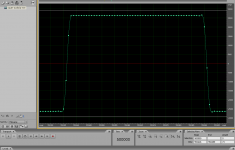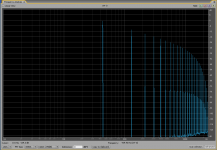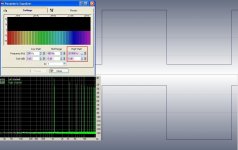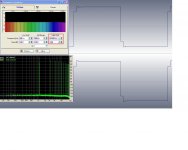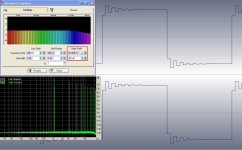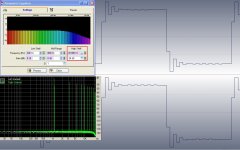I am not sure if Richard is just playing games with us or is it a lack of basic knowledge. Audacity has an option to generate "square, no aliases". It is nothing else but slower rising and falling edge, so there is no overshoot. But, in frequency domain, higher harmonics do have a decreased amplitude - no else possibility. Please check the Audacity "square" zoomed. You will see samples at the edges. This is one of the reasons of me being surprised, as I wrote yesterday. We can see "discoveries" that only reflect lacks of basics. Sorry for me getting unpleasant.
Attachments
Last edited:
Ghosts in the machine
Also, from this review:
Alesis Masterlink
As someone said many moons ago, never turn your back to digital! 😉
IMO, proper test procedure should be as follows:
1. Masterlink's ADC test.
a) Record analog square wave at Fs of your choice to Masterlink.
b) Transfer recorded file from Masterlink's internal drive to your computer without manipulating it (no SRC, no gain change etc.!), load the file into DAW and see if you like your square wave.
c) Put Masterlink in record mode, connect its digital output to digital input of your AP and perform various tests. See what kind of artifacts/noise Masterlink's ADC produces.
2. Masterlink's DAC test.
a) Generate a test file containing square wave at same Fs as above on your computer. (Or download it from internet or ask someone to create it for you).
b) Transfer this test file from your computer to Masterlink's internal drive.
c) Connect Masterlink's analog output to scope, play the test file back and see if you like the result.
Best,
There you go, Richard. Sample rate converter! This is another LPF in your REC/PB chain. Are you sure that you're not looking at its flaws?Maybe it helps if you know the adc sampling is at 24/96 and converted with DSP to redbook spec. for output/burning.
Also, from this review:
Alesis Masterlink
Maybe it is this noise shaped dither responsible for the HF bump that you're seeing on your analyzer?..but if you're making a Red Book audio CD, any high sample rates or bit depths will be converted down to the Red Book-standard 44.1kHz sample rate/16-bit resolution automatically as the CD is burned. If the resolution of the original audio file is greater than 16-bit, noise-shaped dither will also be applied to maximise the dynamic range of the final recording.
As someone said many moons ago, never turn your back to digital! 😉
IMO, proper test procedure should be as follows:
1. Masterlink's ADC test.
a) Record analog square wave at Fs of your choice to Masterlink.
b) Transfer recorded file from Masterlink's internal drive to your computer without manipulating it (no SRC, no gain change etc.!), load the file into DAW and see if you like your square wave.
c) Put Masterlink in record mode, connect its digital output to digital input of your AP and perform various tests. See what kind of artifacts/noise Masterlink's ADC produces.
2. Masterlink's DAC test.
a) Generate a test file containing square wave at same Fs as above on your computer. (Or download it from internet or ask someone to create it for you).
b) Transfer this test file from your computer to Masterlink's internal drive.
c) Connect Masterlink's analog output to scope, play the test file back and see if you like the result.
Best,
Last edited:
On a different note, Merry Christmas and a Happy New Year to one and all, irrespective of any religious beliefes. Goodwill should not be limited by confession. Have a great holiday season and an even better 2016.
We of the orthodox persuasion, like George and myself and our countrymen, celebrate our christmas and new year 2 weeks later. so we accept our burden of having to celebrate it all twice. 😀
We of the orthodox persuasion, like George and myself and our countrymen, celebrate our christmas and new year 2 weeks later. so we accept our burden of having to celebrate it all twice. 😀
No its not what I mean... I mean you want the same signal waveform at the analog output of the CD player as the input.
That is mission impossible.
The input of a CD recorder from the real world has a good probability of being band limited, but in relatively gentle ways.
The output of a CD play must be profoundly band limited.
You get that After further filtering of the 'ringing'. This I have shown/demonstrated. Further elaborated with web site ref.
Unfortunately, those demonstrations that have been posted here lately are not necessarily typical.
I also showed that you can filter the input to the ADC and get same results as filtered on DAC output.... a nice clean sq wave result. Such filter after the DAC output is also known as a reconstruction filter.
The first really obvious failing of the evidence shown here lately is that its frequency, while discernible, may not be very clear.
For example, there is no way to get a clean 10 KHz square wave out of a CD player. OTOH, Getting a fairly good 100 Hz square wave is far more likely, but what does that really mean about audible performance?
A reference from a highly experienced tester of audio gear has been posted on this thread lately that cast doubts on the relevance of square wave testing.
Technically, he's to the left of me, because I will tell you that square wave testing of audio gear is just about utterly meaningless.
The problem with square waves is that their visual apparent accuracy is heavily based on phase accuracy. Minor changes in phase cause dramatic-looking changes to square waves. This drama often puts too much emphasis on the importance of small phase errors that the ear is not sensitive to.
The study of psychoacoustics shows that the human ear simply has no way to appreciate phase response over much of the high frequency end of the audio range. That this is true is not controversial among well-informed people. The exact frequency above which the ear looses its sensitivity to phase is a bit controversial, but only a bit.
At low frequencies, the fact that rooms generally mangle speaker phase response may be the more relevant influence. Phase accuracy in electronic equipment is almost never conveyed to the ear at low frequencies.
Last edited:
Slowly making progress...... Audacity says they cant open it because it is an audio CD file and I have to convert it to wav first. Nice.
Good thing I am here alone for a week... freezing outside... snowing tomorrow. I have enough raw food stocked for a few more days...... maybe i wont have to learn how to cook.
My neighbors have taken pity on me and Patti or John make an extra plate and bring it over to me. [They know I cant cook.] ...
-RNM
One simple way to obtain a .wav file from a CD is to use a well-known freeware problem called EAC. CDEX is a another good standard program. Their user interfaces and feature lists are a bit differnt, but they will generally give you comparable results.
Last edited:
May I ask what is the problem here? I don't know how to make a .wav file either. Want to give me a hard time about it? '-) We all have or strengths and omits. Richard has more audio experience than almost anyone here, including his debunkers. We should appreciate it.
The problem here is that people often don't know what they don't know or if they have some idea about what they don't know, they don't give that information the respect that it may in general, deserve.
Take recent events where some people who have apparently spent their lives tightly focused on some areas of audio, but totally ignored others that may have evolved and vastly increased in their importance while they were focusing their attention elsewhere.
So now we have some people before who think of themselves as world-class experts in audio but have less experience and understanding in certain areas of digital audio than some 10 year olds.
May I ask what is the problem here? I don't know how to make a .wav file either.
This is not surprising. They were developed after 1968.
This is not surprising. They were developed after 1968.
1990 actually.
What would be illuminating is if someone has data to show any significant effect of this low level high frequency noise on performance of common circuits in the audio band.
It is impossible to generalize on every piece of audio gear.
Thing to remember that if a digital Full Scale signal is 2 volts, 60 dB below that is 2 millivolts. This should be typical for line level signals.
We are primarily worried about IM nonlinear distortion down-shifting noise and spurious responses > 20 KHz down into the audio band particularly to frequencies like around 4 KHz where the ear is most sensitive.
One of the inherent properties of most nonlinearities other than crossover distortion, is that the spurious responses decrease even faster than the signal decreases.
For example, the spurious responses due to a second order nonlinearity (the worst case) will decrease with the square of the size of the signal, so a -60 dB signal will create a spurious response that is at least 120 dB down.
I say "at least" because that second order nonlinearity example has some kind of a corefficient <<1 that is associated with it. For example, for a piece of audio gear that has 0.1% THD that coefficient is 1/1000 or another -60 dB loss. So the spurious responses associated with a digital filter with -60 dB response (a poor modern filter) used with an amplifier that has 0.1% THD in the worst case will create a spurious response that is more like 180 dB down.
At this point, I've only talked about the technical performance of the equipment. Most musical program material has built-in substantial high frequency losses above a few KHz. So the actual spurious responses might be more like 200 dB down.
How does all of this evidence itself to the CD listener who has a reasonably acceptable replay system?
Refocus -
 Lots of good info --- a lot of it not too relevant to me and also known. Some unknown to me. I can not put everything in forum notes. To me it is shorthand writing. Not unlike texting. Refocusing;
Lots of good info --- a lot of it not too relevant to me and also known. Some unknown to me. I can not put everything in forum notes. To me it is shorthand writing. Not unlike texting. Refocusing;
The filtering is not adequate IMO. Regardless of what is already done in processing. Maybe it isnt typical. I dont know that.
The Gibb affect (and its ringing) is a pointer to me that the filtering is not as I would like it. It is a fast way - using square waves - to tell.
The HF noise is first and foremost clearly the potential problem. IMO. Though, the effect on any one particular power amplifier or tweeter is unknown to me, I do plan to find out something about that, next.
On the more practical side of things --- this is a Mastering machine. It has long been reported by mastering engineers that they heard most filters affect on the sound. I believe this is likely group-delay being too high.
But audio is naturally of limited BW and maybe an input filter isnt needed all the time. (we dont record gun shots all that often). It may be that an output filter is also audible to them. But for use in my home as only a playback machine, I want that filtering in there.... but it must be really, really good. As JC will tell you from his and critical feedback, it is hard to make a filter that doesnt do something to the sound.
Who makes or can design a Bessel filter at about 50-75KHz -3db with GD which is below audible limits as indicated in the latest literature on hearing -- such as, Communication Acoustics by V.Pulkki and M. Karajalainen?
In my case, with this machine, when I filtered the DAC output further, the Gibbs ringing was just about all gone, also. I used Both the gibbs ringing and the spectrum analyzer to find the best filter point. but, you need very low GD also. If you do this, you will have made another small step for mankind.
😎🙂
THx-RNMarsh
 Lots of good info --- a lot of it not too relevant to me and also known. Some unknown to me. I can not put everything in forum notes. To me it is shorthand writing. Not unlike texting. Refocusing;
Lots of good info --- a lot of it not too relevant to me and also known. Some unknown to me. I can not put everything in forum notes. To me it is shorthand writing. Not unlike texting. Refocusing; The filtering is not adequate IMO. Regardless of what is already done in processing. Maybe it isnt typical. I dont know that.
The Gibb affect (and its ringing) is a pointer to me that the filtering is not as I would like it. It is a fast way - using square waves - to tell.
The HF noise is first and foremost clearly the potential problem. IMO. Though, the effect on any one particular power amplifier or tweeter is unknown to me, I do plan to find out something about that, next.
On the more practical side of things --- this is a Mastering machine. It has long been reported by mastering engineers that they heard most filters affect on the sound. I believe this is likely group-delay being too high.
But audio is naturally of limited BW and maybe an input filter isnt needed all the time. (we dont record gun shots all that often). It may be that an output filter is also audible to them. But for use in my home as only a playback machine, I want that filtering in there.... but it must be really, really good. As JC will tell you from his and critical feedback, it is hard to make a filter that doesnt do something to the sound.
Who makes or can design a Bessel filter at about 50-75KHz -3db with GD which is below audible limits as indicated in the latest literature on hearing -- such as, Communication Acoustics by V.Pulkki and M. Karajalainen?
In my case, with this machine, when I filtered the DAC output further, the Gibbs ringing was just about all gone, also. I used Both the gibbs ringing and the spectrum analyzer to find the best filter point. but, you need very low GD also. If you do this, you will have made another small step for mankind.
😎🙂
THx-RNMarsh
Last edited:
So now we have some people before who think of themselves as world-class experts in audio but have less experience and understanding in certain areas of digital audio than some 10 year olds.
I feel that is a little unfair. I suspect the number of 10 year olds who understand the digital audio process is exceedingly small. Whilst I have never met one the world is a big place so there must be a few of them somewhere, but they would be exceptional individuals.
We are primarily worried about IM nonlinear distortion down-shifting noise and spurious responses > 20 KHz down into the audio band particularly to frequencies like around 4 KHz where the ear is most sensitive.
It may have drifted to that, but actually the starting point was what happens with noise injected that is outside the closed loop bandwidth of the amplifier and does this infer that 100KHz minimum BW on power amplifiers is a good design goal because of this. But like all things the plot was lost.
1990 actually.
Yes, that's after 1968. At least in the number system I use.
The Gibb affect (and its ringing) is a pointer to me that the filtering is not as I would like it. It is a fast way - using square waves - to tell.
The HF noise is first and foremost clearly the potential problem. IMO. Though, the effect on any one particular power amplifier or tweeter is unknown to me, I do plan to find out something about that, next.
THx-RNMarsh
The Gibbs ringing is just a function of a step response (as in square wave) low pass filtered. Having it is correct, the maths insists on it. It is not causing the HF noise you are seeing, which 'may' cause issues down stream that is worth filtering out. For me its whether any effect can be measured that is interesting.
That Gebb phenomenon ripple occures when you have an input signal BW or Tr that is faster than the ADC/DAC system. When you filter the input transistion times down slower the "ripple" reduces. I can watch this happen because I can vary the Tr and Tf of the step transition of the sq wave via the HP-3012B controls.
Richard
I was confused from the beginning when you said that HF limiting the output of the DAC for to reduce the out of band noise, reduces at the same time the sqw waviness as well.
The opposite is true regarding sqw waviness. The more HF limiting we apply at the DAC output, the less out of band noise comes out of course but then and due to HF limiting, the more waviness is observed on the square wave tops & bottoms. This is the Gibbs phenomenon
celebrate our christmas and new year 2 weeks later. so we accept our burden of having to celebrate it all twice. 😀
Dejan, here we have officially switched to the new calendar some decades now (see PM) but I will never say no to dual celebrations if they are accompanied by drink food and good company
My Wishes to all for Health, Happiness and Freedom (the all current Flower Power moto) plus strong guts for more diy
George
Attachments
The Gibbs ringing is just a function of a step response (as in square wave) low pass filtered. Having it is correct, the maths insists on it. It is not causing the HF noise you are seeing, which 'may' cause issues down stream that is worth filtering out. For me its whether any effect can be measured that is interesting.
I know that. Again. I know that. I still found it useful indicator of where the best place to put my filter cut-off along with the spect analyzer data. it will give you the best compromise freq. for your filter design.
https://www.google.com/webhp?sourceid=chrome-instant&ion=1&espv=2&ie=UTF-8#q=Gibbs+phenominon
THx-RNMarsh
Last edited:
On a different note, Merry Christmas and a Happy New Year to one and all, irrespective of any religious beliefes. Goodwill should not be limited by confession. Have a great holiday season and an even better 2016.
We of the orthodox persuasion, like George and myself and our countrymen, celebrate our christmas and new year 2 weeks later. so we accept our burden of having to celebrate it all twice. 😀
Agreed, same to you, and yours!
I feel that is a little unfair. I suspect the number of 10 year olds who understand the digital audio process is exceedingly small. Whilst I have never met one the world is a big place so there must be a few of them somewhere, but they would be exceptional individuals.
I think that you don't pay enough attention to what I actually write, because you're responding to something that I didn't say.
You and I are going to have trouble until you actually read what I write, I can guarantee that!
What I wrote is:
"So now we have some people before who think of themselves as world-class experts in audio but have less experience and understanding in certain areas of digital audio than some 10 year olds."
The key words I wrote that it seems completely obvious that you have not one clue were there, is: "in certain areas of digital audio"
You're responding as if I claimed that there are a lot of 10 year olds that have a general understanding of digital audio. I didn't say that, and I even stuck in a phrase namely "in certain areas of digital audio"
that says otherwise.
As long as you read me writing stupid crap when I specifically try to avoid it, its not going to be a good thing!
BTW the area of digital audio that a significant number of 10 year olds have mastered is ripping CDs and working with .wav files. This is because they are making MP3 and AIF files for their phones, PCs, and portable digital players.
Last edited:
- Status
- Not open for further replies.
- Home
- Member Areas
- The Lounge
- John Curl's Blowtorch preamplifier part II
